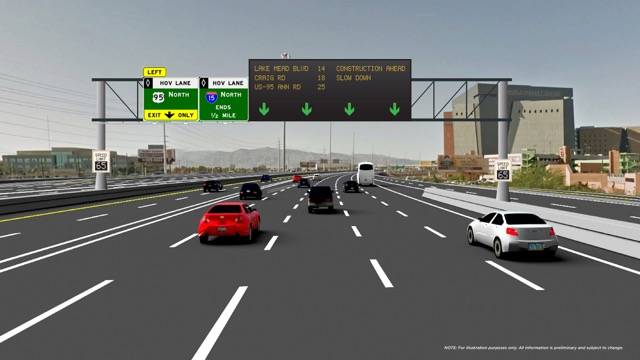
Courtesy of NDOT
The Nevada Department of Transportation is installing 52 Active Traffic Management signs as part of Project Neon, as shown in this rendering.
Wednesday, Nov. 22, 2017 | 2 a.m.
Tina Quigley has a terrific line: “Technology is the new asphalt.”
What she means is that as the Las Vegas Valley grows and traffic becomes more congested, the answer is to use technology to ease it, as opposed to laying down more roads. Quigley, the general manager of the Regional Transportation Commission of Southern Nevada, dropped the line Tuesday when she met with Sen. Catherine Cortez Masto and a group of about 30 state, regional and local leaders to discuss the future of the state’s transportation infrastructure and systems.
Technology that promises to smooth out traffic flows and make the roads safer is already being tested in the valley, and more is in development.
It includes software and sophisticated monitoring devices that can be used to predict trouble areas or times of heavy congestion, and vehicle data-sharing capability that could eventually allow cars to exchange info with other cars and with organizations that monitor traffic, like the RTC, to reroute around accidents and bottlenecks.
There are smart traffic lights and even light poles, which would be fitted with a range of sensors and monitors to do everything from detecting gunshots to activating flashers and message boards at the lights if a car were approaching too fast or coming the wrong way down a one-way street.
It’s designed to cut down on vehicle miles driven on roads by improving traffic flow and paving the way for a future in which more drivers travel in autonomous vehicles available on a subscription or per-ride basis than in private cars.
The upshot of the meeting: Changes — seismic ones — are coming.
To help prepare for them, Cortez Masto has introduced legislation to expand a grant program for cities to make technological upgrades in their traffic infrastructure and transportation systems. Under Cortez Masto’s proposal, 5 percent of the Republicans’ tax reform plan would be set aside to provide up to $80 million for each of two large or mid-sized cities and up to $20 million for two rural communities or regional partnerships.
The proposal hasn’t received a hearing, and with the tax reform bill expected to add to the federal deficit it’s unclear whether Cortez Masto and her partner in the legislation, Sen. Richard Burr, R-N.C., will be able to persuade their colleagues to fund the grants.
But Cortez Masto said she was confident the funding would come through.
“This is one area that is bipartisan,” she said. “If we really want to create jobs and grow the economy, let’s invest in our infrastructure. If we’re going to talk about tax reform and repatriating some of these dollars, why don’t we take 5 percent of these repatriated dollars and invest them in our infrastructure?”
Regardless of what happens with the bill, local officials are moving forward with technological developments like the downtown shuttle and a smart crosswalk in downtown Las Vegas, which is fitted with sensors that provide traffic engineers with a range of data that can be used to prevent pedestrian accidents.
Changes are going to happen. Cortez Masto’s proposal would just make them happen more quickly for the cities that won the grants.
